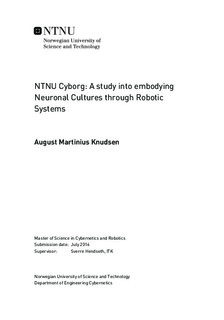NTNU Cyborg: A study into embodying Neuronal Cultures through Robotic Systems
Master thesis
Permanent lenke
http://hdl.handle.net/11250/2414034Utgivelsesdato
2016Metadata
Vis full innførselSamlinger
Sammendrag
Through The NTNU Cyborg initiative, a cybernetic (bio-robotic) organism is currently under development. Using neural tissue, cultured on a microelectrode array (MEA), the goal is to use in-vitro biological neurons to control a robotic platform. This thesis forms the basis for this development, and serves as the preliminary for a further Phd involving the same topics.
Investigation into the the necessary aspects of embodying a neuronal culture though a robotic platform has been conducted. Building upon similar embodied research, as well as knowledge from the fields of neuroscience and computer science, the necessary components for building such a system are discussed.
Beginning with the more practical issues, the MEA2100-60-System for communicating with the neuronal culture was presented, along with a proposed infrastructure for distributing the MEA-Cyborg system across the three main participating departments: The Department of Engineering Cybernetics (ITK), the Department of Neuroscience (INM), and the Department of Computer and Information Science (IDI). Robotic bodies, for embodying the culture, have also been introduced; from Animats and Hybrots to The NTNU Cyborg robot platform.
We have further looked at encoding information to the culture through stimulation, and decoding information from the culture through analyzing the MEA recordings. Through stimulation and recording we propose to 'close the loop' by feeding sensory data from the robot platform to the neuronal culture, and using the culture recordings as robotic instructions.
Training a neuronal culture is one of the more challenging tasks within The NTNU Cyborg project. With inspiration from biology and artificial neural networks (ANNs), we have looked at some mechanisms for training neuronal cultures though supervised, unsupervised and reinforcement type training.
For the sake of completion, a brief discussion on some aspects of modeling a neuronal culture has been included. We have discussed how a realistic model may be constructed and the benefits of doing so.
Finally, putting together the topics discussed in this thesis, a plan moving forward has been suggested for when the MEA is up and running.
